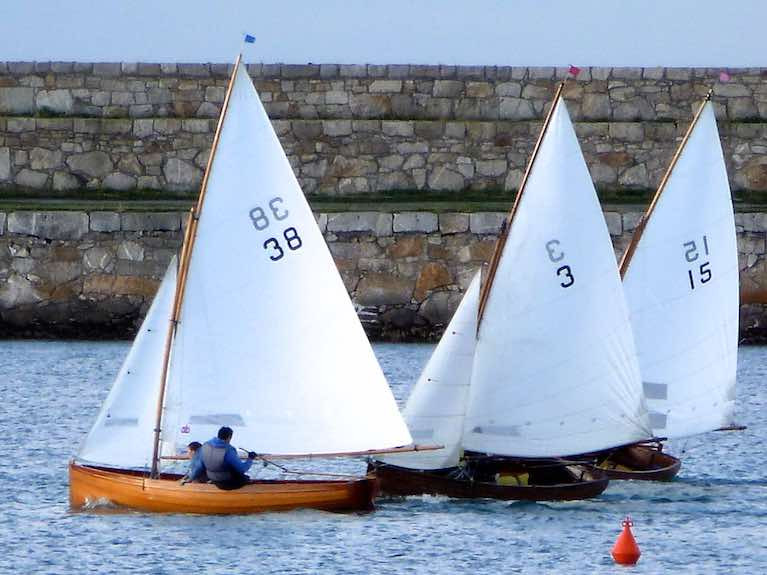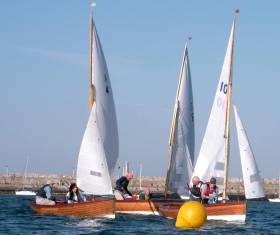Displaying items by tag: Waterwag
Water Wag Captain's Prize Win for Pansy in DBSC Race
There was a bumper turnout of 32 Water Wags for Wednesday night's DBSC Captain’s Prize race at Dun Laoghaire Harbour on Dublin Bay.
After a general recall, Race Officer Tadgh Donnelly lengthened the start line for one of the biggest turnouts of the season.
After a second general recall, Donnelly resorted to the Black flag penalty rule and the race got away with all boats clear.
In a race of three rounds (four beats) and a wind of eight knots, from 090 degrees, the winner was Vincent Delany in Number 3 Pansy, second was Martin Byrne in Number 49, Hilda and third was William Prentice in Number 42, Tortoise.
 Martin Byrne in Water Wag Number 49, Hilda Photo: Ann Kirwan
Martin Byrne in Water Wag Number 49, Hilda Photo: Ann Kirwan
The Murphy family from the National Yacht Club were out in force with Claudine helming no. 41, and Annalise no. 19, and Cathy and Con in no. 45.
26 Water Wag dinghies turned out last night for two Bloomsday races inside Dun Laoghaire Harbour on Dublin Bay.
Dublin Bay Sailing Club Race Officer Tadgh Donnelly ran two races for the fleet that included an on the water tribute to the late DBSC Race official Carmel Winkelmann, who died last Saturday.
DBSC Water Wag Results for Wednesday, June 16th
Race 1: 1. Hilda, 2. Shindilla, 3. Mariposa
Race 2: 1. Shindilla, 2. Swift, 3. Mariposa
After 36 Years, Dun Laoghaire Harbour's Pansy Blooms Again in National Yacht Club 150th Anniversary
The 1906-built Dublin Bay Water Wag Pansy has been in the ownership of the Delany family since 1939. But while she has won many trophies, the absence of medals as prizes in local One Design racing has meant that winning one has been something rare and special, to be celebrated in depth and at leisure. In fact, the last time Pansy won a significant medal was thirty-six years ago, at the Centenary Regatta of Dublin Bay Sailing Club in 1984, when she was sailed to victory by Water Wag legend Alf Delany.
Once upon a time, Alf had the great Eric Tabarly as guest helm on board. But that only served to demonstrate that Pansy definitely needs a Delany to do the driving. These days, the driving Delany is Alf’s son Vincent. And now, Vincent can savour something similar to winning the 1984 medal, because although the main part of the National YC’s 150th Anniversary Regatta is going to be raced this Saturday (September 5th), in best Dun Laoghaire harbour style the weekly Wednesday evening contest of the historic Water Wag class was rated as the opening event of the Sesquicentennial Celebration. And in a fleet of 22 classic clinker-built boats yesterday (Wednesday) evening, Vincent and Pansy were in cracking form, clinching the win and being awarded the first Sesquicentennial Medal by NYC Commodore Martin McCarthy at a socially-distanced post-race dinner in the NYC clubhouse this week.
 Still in the medals, and it only took 36 years…..Pansy’s prizes from 1984 and 2020
Still in the medals, and it only took 36 years…..Pansy’s prizes from 1984 and 2020
People often ask which is the most competitive fleet in Dublin Bay? You will be given twenty different answers, depending on who you ask. However, despite its venerable status, the Water Wag class is experiencing a boost in popularity, because of the competitive ‘large fleet’ racing on offer.
On Wednesday 4th July, the sun continued to shine, and the 10-knot wind with stronger gusts was blowing from an unusual direction, from the south-south-east. The race committee laid the starting line off the West Pier lighthouse with the windward mark off the East Pier bandstand. This created a conundrum for the competitors. Start at the pin end and find that after 200m you would have to tack onto port, requiring you to dip most of the fleet. Thus, the committee boat end was favoured by much of the 28 boat fleet. There was a start under a ‘Blue Peter’, under the ‘U’ flag, and under the ‘black’ flag before the fleet started cleanly.
After the first lap, the leaders were Stephen Tierney and John O’Driscoll visitors from the SOD class in Moosmie, followed by Cathy MacAleavey and Con Murphy in Mariposa which Cathy built herself, and our Olympic star, Annalise Murphy in Mollie.
One lap later it was Moosmie, Mariposa and Guy and Jackie Kilroy in Swift.
At the finish the order was;
45, Mariposa, Cathy MacAleavey & Con Murphy. Winner div. 1A.
15, Moosmie, Stephen Tierney & John O’Driscoll, 1A.
38 Swift, Guy & Jackie Kilroy, 1A.
41, Mollie.1A.
44, Scallywag, Dan O’Connor, Winner div.2.
1, Ethna, 1A.
3, Pansy, 1A.
9, Marie Louise. 1A
46, Mademoiselle, 1B. Winner div. 2.
36, Little Tern, 1A.
32, Skee, 1B.
24, Gavotte, 1A.
30, Sara, 1B.
20, Badger, 2.
47, Peggy, 1B.
33, Eva, 1A.
8, Barbara, 1A.
48, Dipper, 2.
16, Penelope, 2.
43, Freddie, 1B.
26, Nandor, 2.
4, Vela, 1A.
17, Coquette, 1B.
14, Phyllis, 2.
31, Polly, 2
34, Chloe, 2.
29, Patricia, 1A.
Even if it is not the most competitive class in Dublin Bay, it is certainly the most popular one-design class.
16 Water Wags for Lough Boderg Sailing Regatta
In 1903, the clinker built 14–foot 3 inch long Water Wag dinghies from Kingstown, travelled by rail to Dromod Station, from where they were offloaded by their owners, and wheeled on a flat trailer, pulled by a horse, to the Jamestown Canal where they were all launched. The boats then sailed down river to Lough Boderg, for the Annual North Shannon Yacht Club Regatta.
Some one hundred and thirteen years later, Ireland is a very different place. There has been huge improvement in the prosperity of the country, growth in literacy, decline in the rural population, Irish independence, entry into European Community. However some things remain unchanged.
On 15 October 2016, the Water Wag dinghies from Dun Laoghaire (formerly Kingstown), will travel by road to Lough Boderg, where they will be offloaded by their owners, and launched. The boats will race on Lough Boderg, for the two days of the Annual North Shannon Yacht Club Regatta.
The Water Wags which are expected to partake will include a boat built in 1906, boats built in the 1930s, and Water Wags built within the past five years.
How many boats are expected? Although entries are not finalised yet it is to be expected that 16 Water Wags will be racing on the lake. This will be delightful sight for the people of Leitrim and Roscommon, in particular when the distinctive colourful spinnakers are flown. For more information contact [email protected]
#moth – The world's oldest one design dinghy combined with the world's fastest dinghy last weekend at Killinure on Lough Ree for an early season training and racing weekend.
The event started with a social nine holes of golf at the beautiful Glasson Golf Club on Friday evening! Sailing started on Saturday morning with a race in a cold 15-20kt blustery westerly for the seven Waterwags and six Moths from a start line at Quigleys Marina to the finish line at the Wineport Lodge.
The leading Moth Annalise Murphy covered the 2 mile long course in less than 5 minutes! Further races were held on the inner lakes below Glasson Golf Club before the usual excellent lunch in the Wineport and the return sail to Killinure.
After a combined class party in the Killinure Chalet Restaurant on Saturday night, six races were run in the lighter winds on Sunday.
As well as the Moths and Wags, another visitor to Quigleys last weekend was the 40ft Bantry Bay Longboat 'Siann Mhara' recently built by local volunteers in Banagher.
All in all, a great pre-season warm up for the sailors and quite a spectacle!
Photos below by Garrett Leech
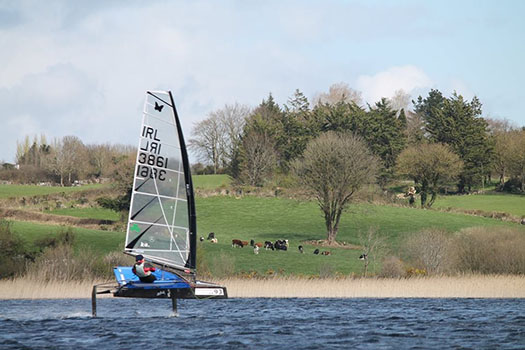


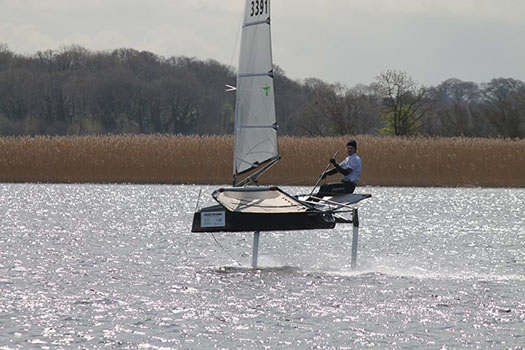
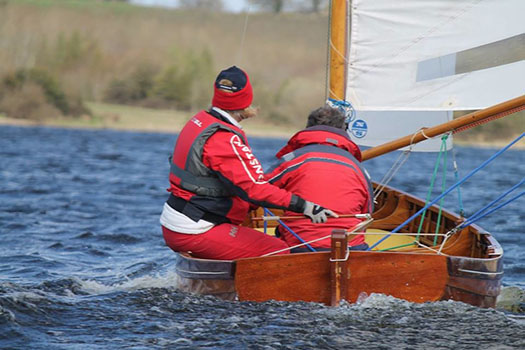
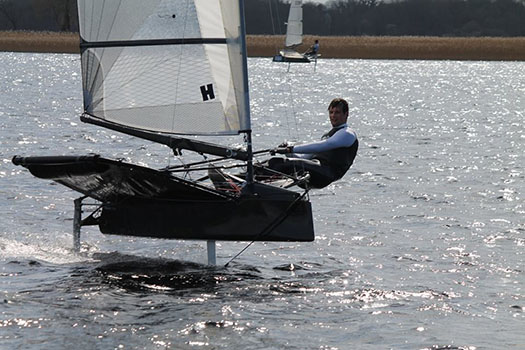
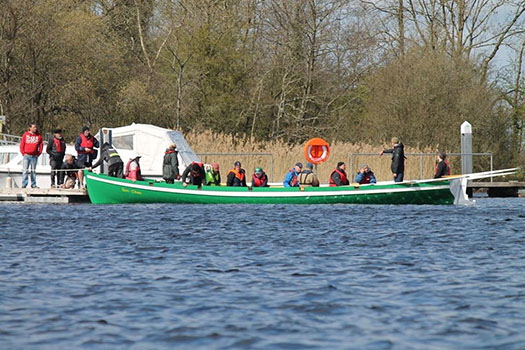
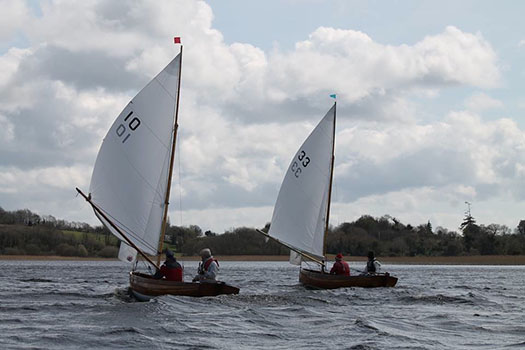
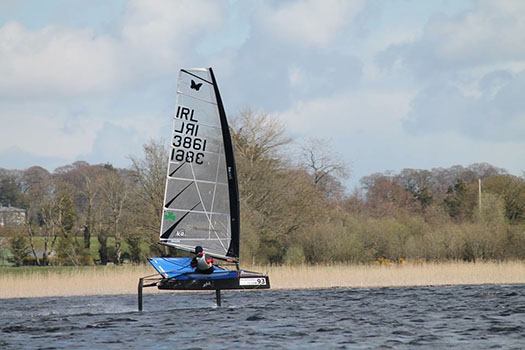


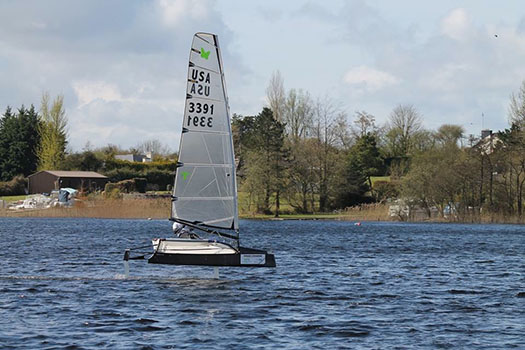
Racing Updates: RAYC Bloomsday, Mermaid, IRC Cowes, Wags, Lasers, Fireballs, Ruffians, Ailsa Craig
#regattas – After a week of rain and gales there was a full programme of yachting round the coast at the weekend with one of the biggest fleets racing for RAYC Bloomsday regatta honours at the National Yacht Club in Dun Laoghaire. From the same club the clinker Waterwags celebrated 125 years of racing on Dublin Bay with a 20–boat fleet and a Victorian high tea yesterday afternoon. There were celebrations too further up the east coast for K. Halliwell's 'She of the North' who won the fiftieth round Ailsa Craig race from the Royal Ulster Yacht Club.
Antrim sailor Chris Penney won the Laser Leinsters at Howth and in a possible sign of good things to come ISAF Youth Rep Finn Lynch of the National YC won the radial division. The Ruffian 23s raced for national honours on Dublin Bay and 20 Fireballs turned up to race for Ulster honours at East Down Yacht Club.
In Cowes, Royal Cork's Anthony O'Leary, who finished second last weekend in the 1720 Nationals on home waters, was second overall again yesterday in IRC one class at a windy British National Cruiser Championships. Great onboard action video from Cowes here.
And finally, if you are on the south coast this week and see a small half decked Mermaid dinghy take the time to say hello. She is currently in Crookhaven, West Cork heading east so expect to see her in Cork harbour this week or next! The clinker built Thumbalina is cruising round the coast from Foynes on the Shannon Estuary to Skerries in North Dublin as part of the eightieth celebrations of the traditional Dublin Bay class.
Waterwag
The Dublin Bay Waterwag lays claim to being the oldest one-design sailing boat in the world. Founded as a class in 1887, the design was modified in 1900 and the rules are essntially unchanged since then.
Afloat's Graham Smith wrote, in the February/March 2009 issue:
You would expect that the venerable Wag would be a class at ease with itself by just trundling along with the same number of boats, year in, year out. If you did, you’d be wrong! Four or five new boats over the previous few years plus a new one this year has brought the fleet to a very respectable 40 in its 121st year of action in the Bay. A number of these are now available to charter or to buy, although the proviso is that they must be sailed in Dun Laoghaire! There was no Wag Worlds in 2008 – it’s every second year so 2009 has the next one – but Frank Guy in Gavotte (Wag no. 24) was the leading light in the Dublin Bay racing scene during the 2008 season.



























